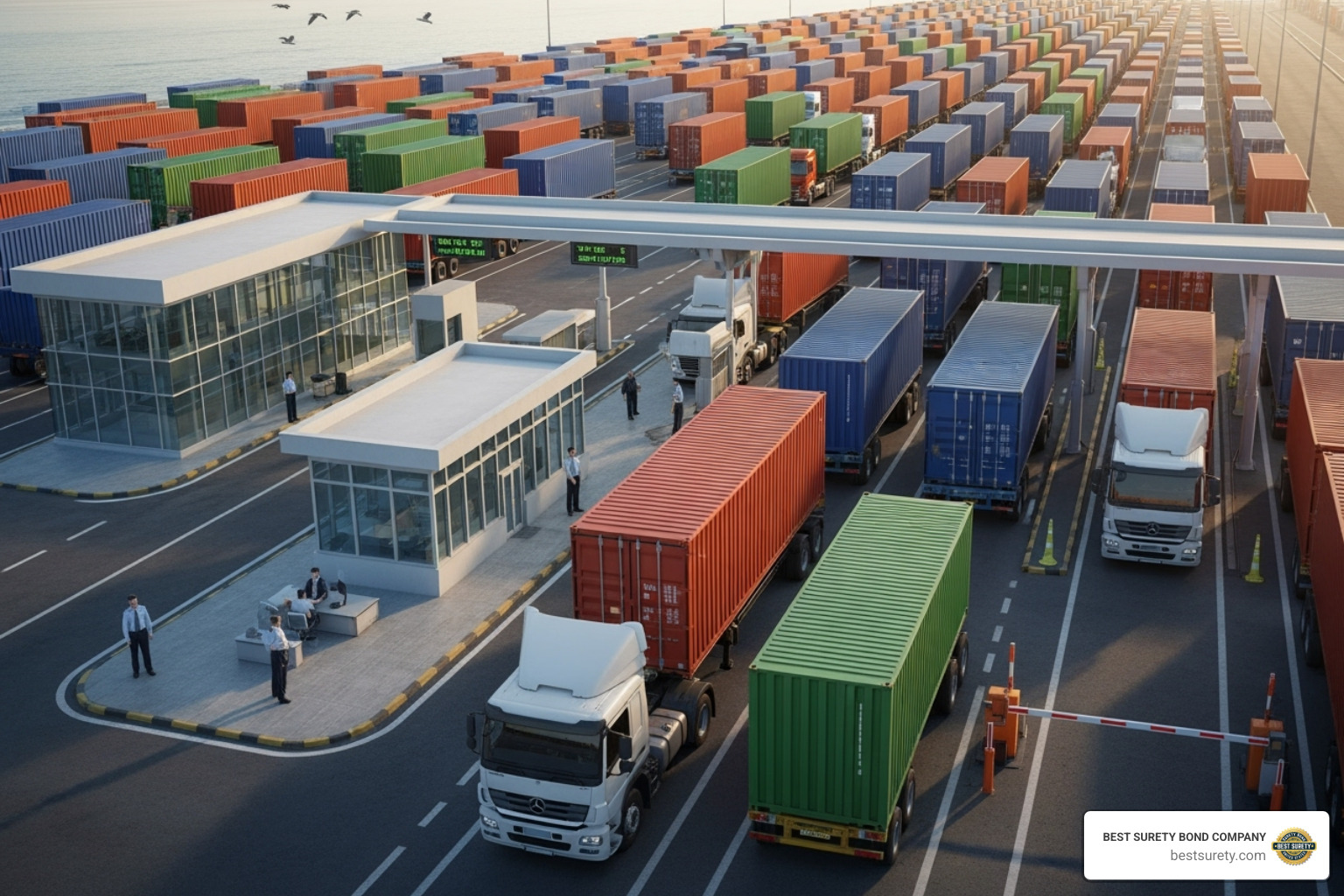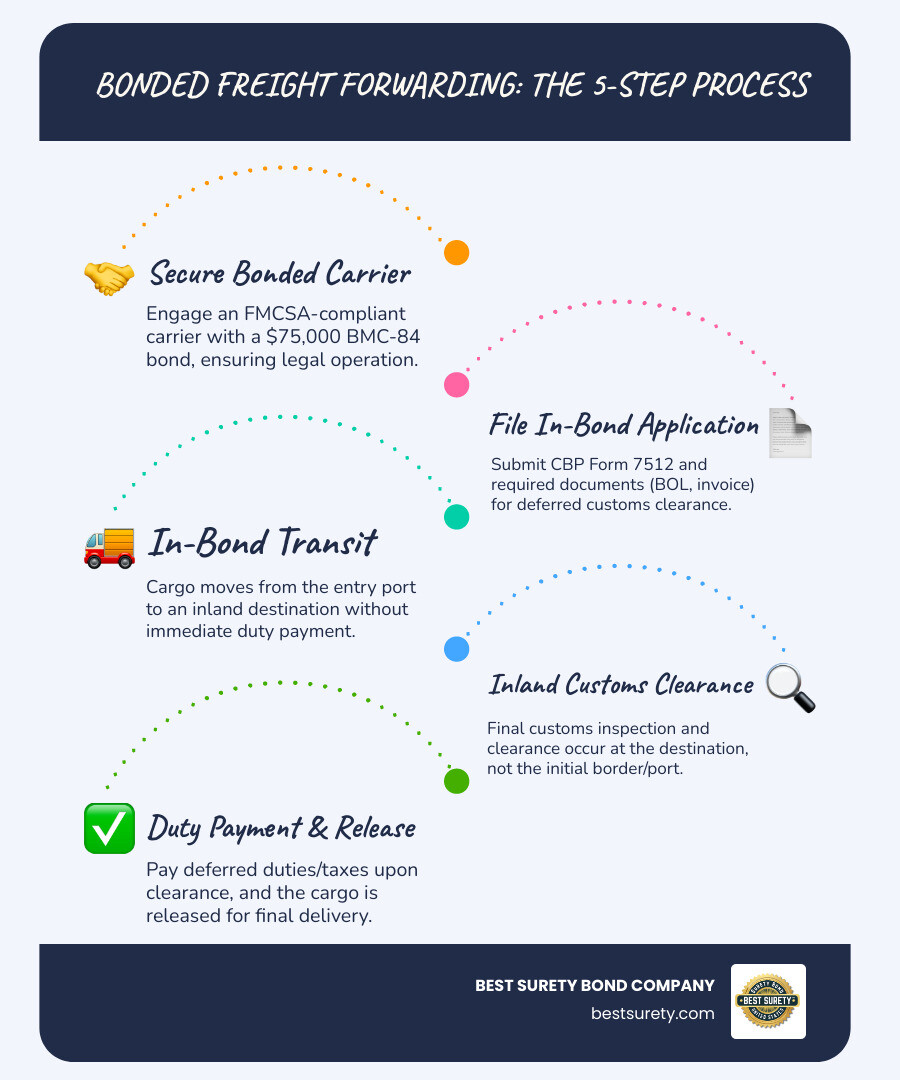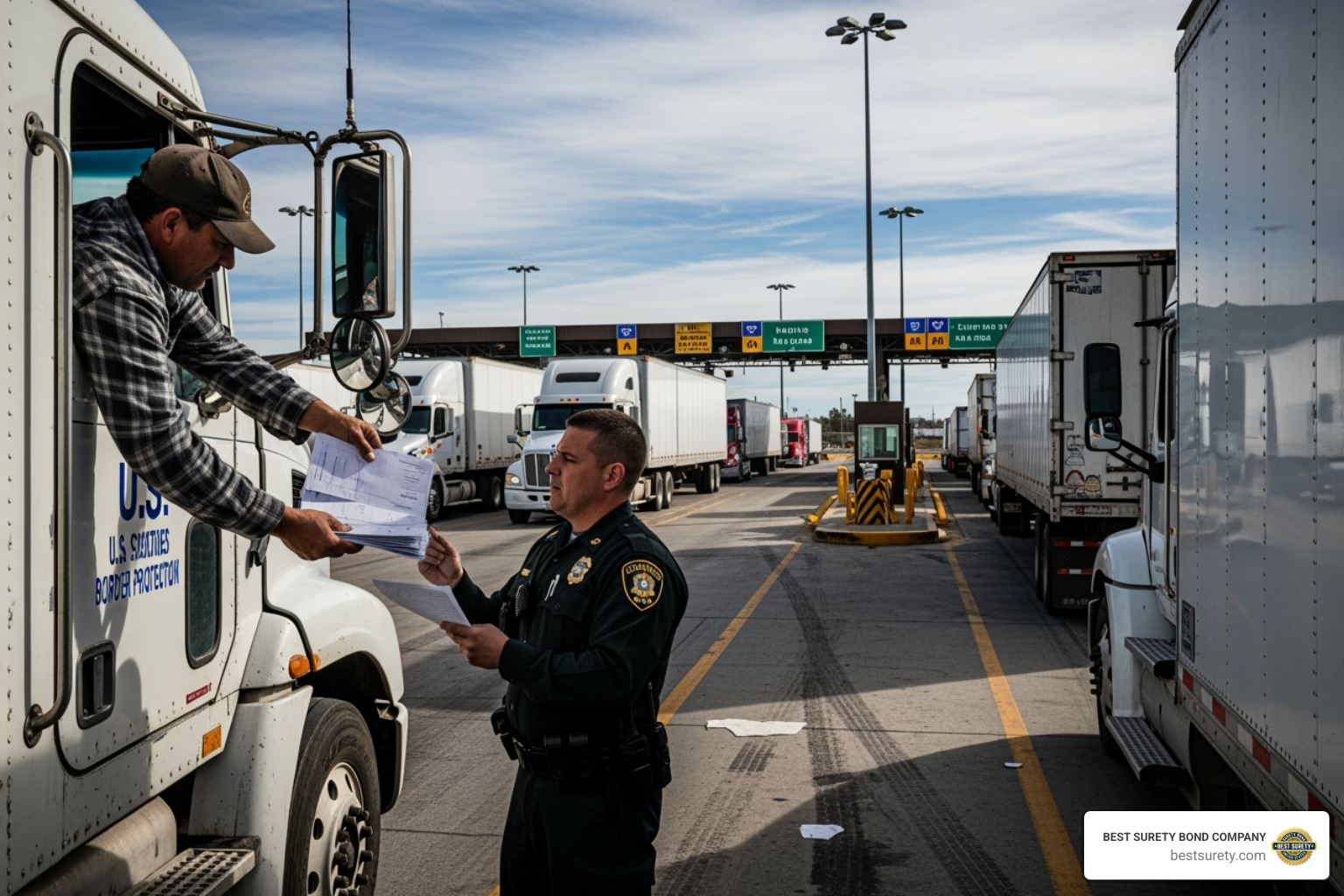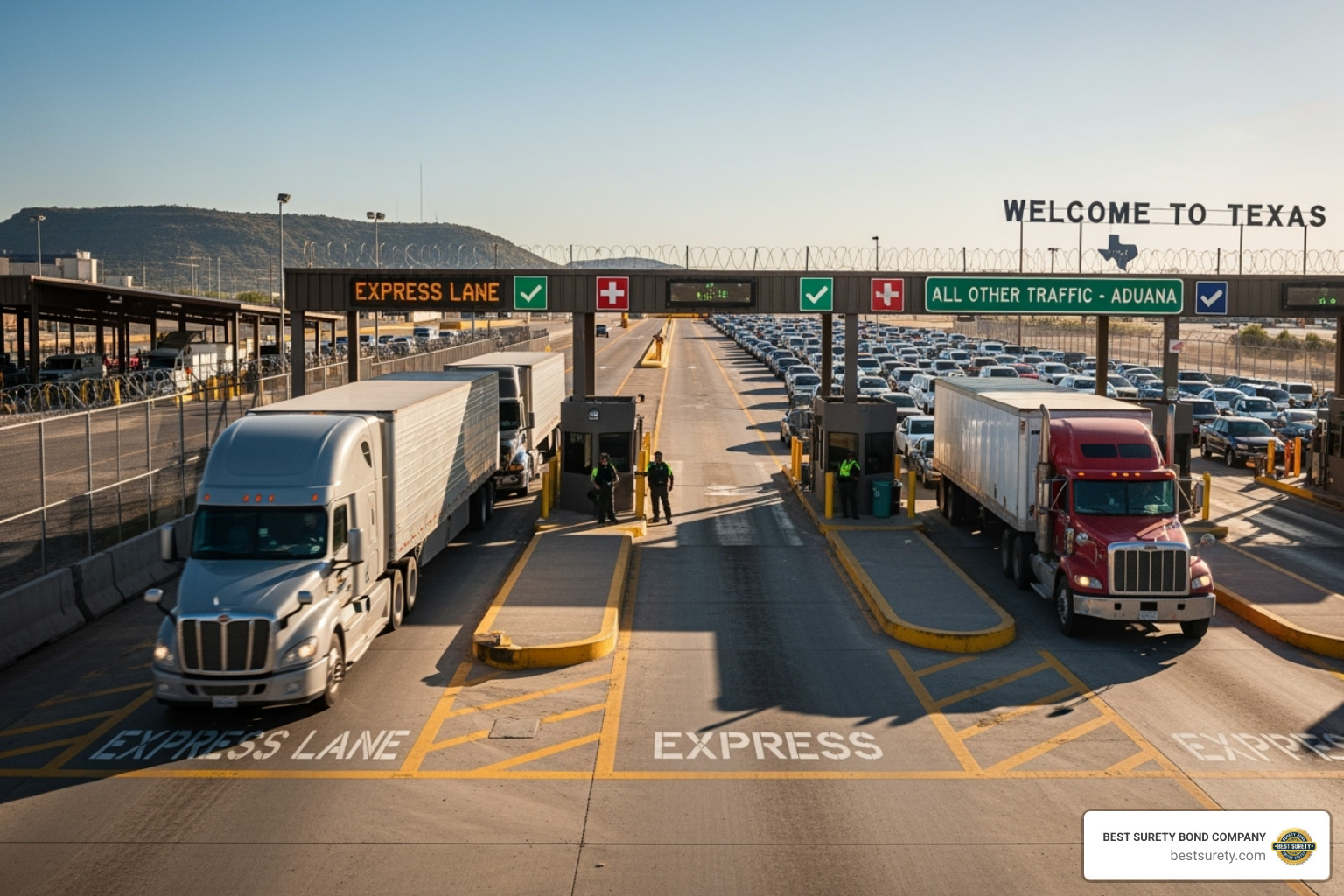Understanding Bonded Freight Operations in Texas and Beyond

Bond freight forwarding involves moving goods across borders using bonded carriers who guarantee payment of duties and taxes through surety bonds. This process allows cargo to move through transit points without immediate customs clearance, making international shipping faster and more efficient.
Quick Answer: What is Bond Freight Forwarding?
- Bonded carriers transport goods under customs bonds, deferring duty payments until final destination
- In-bond shipments move through countries without clearing customs at each border
- BMC-84 bonds ($75,000) are required for freight forwarders to operate legally in the U.S.
- Customs bonds guarantee payment of duties, taxes, and penalties to government agencies
- Financial security protects all parties when goods move across international borders
The freight forwarding industry generated over $732 billion in revenue, with Texas serving as a major gateway through ports like Houston and border crossings at Laredo. Whether you’re shipping through the Port of Houston or moving cargo across the Mexican border, understanding bonded operations is crucial for smooth international trade.
From securing the right BMC-84 bond to navigating customs requirements, the bonded freight process involves multiple moving parts that can make or break your shipping timeline. Small business owners and contractors often find themselves overwhelmed by the complex requirements and worried about choosing the wrong bond provider.
I’m Haiko de Poel, and I’ve spent over two decades helping businesses steer complex financial requirements, including the intricacies of bond freight forwarding operations across multiple industries. My experience scaling ventures in logistics, fintech, and regulatory compliance gives me unique insight into how bonded freight systems actually work in practice.

The Core Component: What is a Freight Forwarder Bond?
Think of a freight forwarder bond as your business passport for bond freight forwarding operations. Without it, you simply can’t legally move goods across borders or operate as a freight forwarder in the United States. It’s not just paperwork – it’s your financial promise to play by the rules.
The bond system creates a safety net that protects everyone involved in your shipping operations. When you secure a freight forwarder bond, you’re essentially bringing three key players together: you as the freight forwarder (the principal), the government agency requiring the bond like the Federal Motor Carrier Safety Administration (FMCSA) or U.S. Customs and Border Protection (CBP) (the obligee), and your surety company that backs your promise with real money.
Here’s where it gets interesting for Texas-based operations. Whether you’re moving cargo through the Port of Houston or handling cross-border shipments at Laredo, different types of bonds serve different purposes in your bond freight forwarding business.
| Bond Type | Purpose | Required By | Beneficiary | Bond Amount |
|---|---|---|---|---|
| BMC-84 Bond | Carrier payment guarantee | FMCSA | Motor carriers | $75,000 |
| Customs Bond | Duties & taxes guarantee | CBP | U.S. Government | Varies by cargo value |
The U.S. Freight Forwarder (BMC-84) Bond
Every freight forwarder operating in Texas and across the nation must secure a BMC-84 bond before they can legally start moving cargo. This $75,000 bond requirement isn’t just a government formality – it’s your ticket to obtaining your Operating Authority (MC number) and maintaining FMCSA compliance.
The BMC-84 bond serves as a carrier payment guarantee, which means if you fail to pay a trucking company for their services, they can file a claim against your bond. The surety company will investigate the claim and pay valid amounts up to the full bond limit. This system keeps the freight industry running smoothly by ensuring carriers get paid for their work.
Getting your BMC-84 bond doesn’t have to be complicated or expensive. We specialize in fast approvals and competitive rates for Texas freight forwarders, often providing same-day bond issuance so you can get your MC number and start operations quickly. The bond premium typically costs just a small percentage of the total bond amount, making it an affordable way to meet federal requirements.
For more details about how license and permit bonds protect your freight forwarding business, visit our comprehensive guide on license & permit bonds.
The Role of Customs Bonds in Bonded Shipments (Context Only)
While your BMC-84 bond covers your obligations to carriers, customs bonds handle a completely different part of the bond freight forwarding equation. These bonds guarantee payment of duties and taxes to U.S. Customs and Border Protection, but here’s the key distinction – your customers (the importers) typically need these bonds, not you as the freight forwarder.
Customs bonds come in two main flavors: Single Entry Bonds for one-time shipments and Continuous Entry Bonds for regular importers. A continuous entry bond usually runs around $500 annually and covers all of an importer’s shipments for the year, while single entry bonds cost about 0.5% of the cargo value with a $50 minimum.
Understanding customs bonds helps you better serve your clients, even though these aren’t typically your direct responsibility as a freight forwarder. The CBP directive on monetary bonds provides detailed guidelines for bond amounts, which you can review at CBP’s official documentation.
This dual-bond system – your BMC-84 for carrier relations and customs bonds for import duties – creates the complete financial framework that makes bond freight forwarding possible from Houston to Laredo and beyond.
Navigating the Bond Freight Forwarding Process in Texas and Beyond
Picture this: You’re standing at the busy Laredo border crossing, watching an endless stream of trucks carrying everything from automotive parts to agricultural products between the U.S. and Mexico. What you’re witnessing is bond freight forwarding in action – a sophisticated dance of documentation, timing, and regulatory compliance that keeps North American trade flowing smoothly.

The beauty of in-bond shipping lies in its efficiency. Instead of getting stuck in customs clearance at every port or border crossing, your cargo can keep moving toward its final destination. Think of it as an express lane for international freight – goods arriving at the Port of Houston bound for Dallas don’t need to clear customs at the port. A bonded carrier can transport them directly to a bonded warehouse or customs facility in Dallas, where formal clearance happens without the port congestion delays.
This system is particularly valuable for US/Mexico and US/Canada cross-border freight, where multiple border crossings and inland ports create potential bottlenecks. Texas serves as a critical gateway in this network, handling millions of tons of cargo annually through major crossings like Laredo, El Paso, and Brownsville.
Key Steps in Bonded Trucking and Shipping
Getting your cargo from point A to point B through bond freight forwarding involves a carefully orchestrated process. Each step builds on the previous one, and missing any piece can bring your shipment to a grinding halt.
Booking a bonded carrier is your first critical decision. Not every trucking company can handle in-bond shipments – your carrier must be authorized and have posted financial security with customs agencies. This isn’t just paperwork; it’s your guarantee that your freight will move legally and efficiently across borders.
Before your shipment even leaves its origin, someone needs to be filing an in-bond application with the appropriate customs authority. This application tells customs exactly what’s moving, where it’s going, and when it should arrive. It’s like making a reservation for your cargo’s journey through the customs system.
The ACI eManifest requirement adds another layer of advance planning, especially for shipments crossing into Canada. Carriers must submit electronic manifest data to the Canada Border Services Agency before arrival. The U.S. has similar electronic manifest requirements, creating a digital trail that customs officials use to track and verify shipments.
During cargo transit, your goods remain under customs control even though they’re physically moving. The bonded carrier becomes responsible for delivering the shipment to its designated destination – no unauthorized stops or diversions allowed. This is where having a reliable, experienced carrier becomes crucial.
Final customs release only happens when your shipment reaches its intended destination and a customs broker files the formal entry. Until duties and taxes are paid and customs gives the green light, your cargo stays locked up. The whole in-bond process leads to this moment of release.
One detail that trips up many carriers is the barcode labels requirement. Highway carriers operating into Canada have just 30 days after receiving their carrier code to obtain and display these labels. Miss this deadline, and you’re looking at a $1,000 administrative penalty – a costly oversight that proper planning can easily avoid.
Essential Documentation for Bonded Shipments
Documentation in bond freight forwarding isn’t just bureaucratic red tape – it’s the communication system that keeps your shipment moving. Each document serves a specific purpose, and customs officials know exactly what to look for.
The in-bond application serves as your formal request to move goods through a country without immediate customs clearance. This document provides customs with essential details about your shipment and its planned route, creating the legal framework for the entire process.
CBP Form 7512 acts as the tracking system for U.S. customs, monitoring goods transported under bond from entry to exit points. This form captures everything from consignee information to estimated departure dates, creating an audit trail that customs uses to verify compliance. You can review the actual form requirements at CBP Form 7512.
Your commercial invoice provides the financial foundation for customs valuation, detailing the transaction between buyer and seller. Customs officials use this document to determine duties and verify that the declared value matches the actual transaction.
The Bill of Lading (BOL) creates the legal contract between shipper and carrier while serving as proof of receipt. This document becomes crucial if disputes arise about cargo condition or delivery terms.
A detailed packing list helps customs officials verify cargo contents without opening every container. This document should match exactly what’s in your shipment – discrepancies can trigger inspections and delays.
Finally, the Harmonized Tariff Schedule (HTS) number classification determines duty rates and import requirements. Getting this wrong can result in penalties, delays, or even cargo seizure, making accurate classification essential for smooth clearance.
Requirements for Becoming a Bonded Carrier
Becoming a bonded carrier involves more than just filling out forms – it’s about proving your financial stability and operational competence to government agencies. The requirements vary by country and transportation mode, but the underlying principle remains consistent: carriers must demonstrate they can fulfill their obligations.
Carrier code application starts the process, with agencies like the Canada Border Services Agency limiting companies to one code per legal entity per transportation mode. This code becomes your identifier in the customs system, linking all your shipments to your bonded status.
U.S. and Canada Border Services each have their own requirements and processes. In Canada, posting financial security typically ranges from $5,000 to $25,000 for highway carriers, while air carriers might need $10,000 to $80,000, and rail carriers often require $80,000. These bond amounts reflect the higher risk and value associated with different transportation modes.
The application process demands attention to signatory requirements – only company officers with legal signing authority can submit applications. If someone else signs, you’ll need certified copies of bylaws authorizing their signature, along with witness signatures. These requirements protect against fraud and ensure proper corporate authorization.
Once approved, carriers must complete testing for transmitting Advance Commercial Information and obtain those critical barcode labels within the specified timeframe. The entire process can take weeks or months, making advance planning essential for companies entering the bond freight forwarding business.
At Best Surety Bond Company, we understand that navigating these bonding requirements can feel overwhelming. That’s why we offer fast approvals and competitive rates for freight forwarders across Texas and nationwide, helping you focus on moving cargo while we handle your bonding needs.
Bonded vs. Non-Bonded Carriers: A Critical Distinction
The choice between using a bonded or non-bonded carrier is a fundamental decision in bond freight forwarding, impacting speed, flexibility, and cost. Think of it as the difference between having a VIP pass and waiting in the regular line at a busy Texas border crossing.

A bonded carrier has posted financial security with customs authorities, giving them the authorization to transport goods “in-bond” past the first point of arrival without immediate customs release. Picture a shipment crossing at Laredo – a bonded carrier can move that cargo directly to Dallas or Houston where customs clearance happens later, rather than getting stuck at the border.
This capability translates into real business advantages. Deferred duties mean importers don’t pay taxes until goods reach their final destination, improving cash flow significantly. Faster transit times become possible because shipments bypass immediate customs clearance at congested ports of entry – a huge advantage when you’re dealing with time-sensitive cargo through busy Texas crossings.
The flexibility factor can’t be overstated. Bonded carriers can move goods to bonded warehouses or between different customs facilities before final release. This prevents those dreaded storage fees that pile up when shipments get delayed at the initial port of entry.
In contrast, a non-bonded carrier faces stricter limitations. Every shipment must be fully released at the first point of arrival – no exceptions. If cargo arrives at the border, customs must clear it completely right there before the carrier can move it inland.
These limitations of non-bonded carriers create real headaches. Shipments can get held up at the border if documentation is incomplete or payment is pending. Even routine inspections can cause significant delays, leading to storage fees, examination charges, and frustrated customers. The lack of flexibility means goods can’t be moved to inland bonded warehouses for later clearance.
For businesses regularly shipping through Texas’s busy ports and border crossings, utilizing bonded carriers isn’t just convenient – it’s essential for maintaining efficient supply chain operations.
How a Non-Bonded Carrier Can Handle a Bonded Load
Here’s where things get interesting. While non-bonded carriers generally can’t transport in-bond goods, there’s a workaround: the Single Trip Authorization Bond.
Think of this as a temporary bonding solution for one-off shipments. When a non-bonded carrier unexpectedly finds themselves with an in-bond load, they can obtain this special authorization. The process involves posting security at the first point of arrival – usually cash or a certified check with the customs agency at the border.
This temporary bonding provides the necessary financial guarantee for that specific shipment to proceed inland under customs control. It’s primarily used for unusual situations or when regular bonded service isn’t available.
However, for businesses engaged in regular bond freight forwarding operations, obtaining continuous bonded carrier status through proper surety bonds is far more efficient and cost-effective. That’s where we come in – helping carriers and freight forwarders secure the bonds they need for smooth operations across Texas and nationwide.
Frequently Asked Questions about Freight Forwarder Bonds
When you’re diving into bond freight forwarding, questions naturally arise. After helping thousands of businesses across Texas and nationwide steer these requirements, I’ve noticed the same concerns come up repeatedly. Let me address the most common ones with straight answers that’ll help you move forward confidently.
What are the costs associated with in-bond shipments?
Understanding the financial side of in-bond operations helps you budget properly and avoid surprises. The costs break down into several categories, each serving a specific purpose in the bond freight forwarding process.
Bond premiums represent your biggest upfront consideration. For freight forwarders, a $75,000 BMC-84 bond typically starts around $938 annually, though your actual rate depends on factors like credit score and business history. We specialize in securing competitive rates with fast approvals, often getting you approved the same day you apply.
Carrier fees add another layer, as bonded carriers may charge premiums for their specialized services. This makes sense when you consider the extra compliance work and financial security they provide. Think of it as paying for expertise that keeps your shipments moving smoothly.
Warehouse storage fees kick in if your goods wait at bonded facilities for customs clearance. These charges accumulate daily, so efficient documentation becomes crucial for controlling costs. Re-delivery fees follow once customs releases your goods, covering transport from the bonded warehouse to the final destination.
Don’t overlook potential administrative penalties either. Something as simple as missing barcoded labels within 30 days of receiving your carrier code can cost you $1,000. These details matter in bonded operations.
For importers needing customs bonds separately, a continuous entry bond runs about $500 yearly, while single entry bonds cost roughly 0.5% of goods’ value (minimum $50). Ocean shipments add another $75 for ISF bonds.
While these costs exist, the efficiency gains and compliance benefits typically outweigh expenses, especially for high-volume operations moving through Texas’s busy ports and border crossings.
What types of cargo can be shipped in-bond?
The beauty of bond freight forwarding lies in its versatility. Nearly any legitimate cargo can move in-bond, provided you have proper documentation and use authorized bonded carriers.
Containerized cargo represents the most common type, whether you’re shipping full truckloads or less-than-truckload quantities. Dry van freight covers your standard enclosed trailer shipments carrying everything from electronics to textiles.
Open deck freight works perfectly for oversized items that need flatbed transport. Roll-on/roll-off cargo includes vehicles and heavy machinery that drive directly onto ships or trailers. Breakbulk shipments handle those unique, individually loaded items like industrial equipment or construction materials.
The key requirement? Your goods must remain under customs control until official clearance at the final destination. This prevents multiple duty payments when cargo transits through countries where it’s not intended for consumption.
Certain restricted goods still face specific regulations and may need special permits for in-bond movement. But for standard commercial cargo moving through Houston’s port or across the Laredo border crossing, in-bond shipping provides remarkable flexibility for diverse industries.
What is the difference between a BMC-84 Bond and a BMC-85 Trust Fund?
When securing your FMCSA operating authority, you’ll choose between two options for meeting the $75,000 financial security requirement. Both accomplish the same regulatory goal but work very differently in practice.
The BMC-84 surety bond operates like insurance for your business obligations. You pay a small annual premium (starting around $938) while we guarantee the full $75,000 to the FMCSA. This surety bond approach frees up your capital for operations and growth.
The BMC-85 trust fund agreement requires you to deposit the entire $75,000 in cash with a financial institution. While you avoid annual premiums, that significant sum sits locked away instead of working in your business.
Collateral requirements highlight the biggest difference. The BMC-84 bond needs no full collateral upfront – just your annual premium payment. The trust fund ties up your entire $75,000 immediately.
For new businesses or those with limited capital, the surety bond makes perfect sense. You meet federal requirements without depleting cash reserves needed for equipment, staff, and daily operations. Established companies with substantial liquid assets might consider the trust fund option, but most find the bond more practical.
We handle BMC-84 bonds with electronic filing directly to the FMCSA, often providing same-day approvals. This speed matters when you’re ready to launch operations or expand your freight forwarding business across Texas and beyond.
The choice usually comes down to cash flow. Would you rather pay a manageable annual premium or lock up $75,000 that could otherwise fuel your business growth?
Get Your Freight Forwarder Bond Fast in Texas and Nationwide
The world of bond freight forwarding doesn’t have to feel overwhelming, even when you’re staring down federal requirements and tight deadlines. Your BMC-84 bond isn’t just another piece of paperwork – it’s the foundation that keeps your freight forwarding business running legally and builds the trust that motor carriers need to work with you.
Here in Texas, where ports like Houston handle millions of tons of cargo annually and border crossings at Laredo never sleep, having your bond sorted quickly can mean the difference between landing that big contract and watching it slip away. We’ve seen too many freight forwarders get stuck in bureaucratic quicksand, waiting weeks for bond approval while their competitors move ahead.
That’s exactly why we built BEST SURETY BOND COMPANY differently. We know that when you need a freight forwarder bond, you usually needed it yesterday. Our fast approvals aren’t just a marketing promise – we’ve streamlined our entire process so you can get instant quotes online and often walk away with same-day issuance. No more crossing your fingers and hoping your bond comes through in time.
Low rates matter too, especially when you’re building a freight forwarding business from the ground up. We work hard to offer the most competitive premiums in the industry, whether you’re operating out of Houston’s busy port district or managing cross-border shipments through El Paso. Your BMC-84 bond premium should fit your budget, not break it.
As Houston’s trusted surety provider, we understand the unique challenges of Texas freight operations. But our reach extends far beyond the Lone Star State – we’re licensed in all 50 states and have successfully bonded over 10,000 clients nationwide. That BBB Accreditation on our wall? It represents real relationships with real businesses who trusted us with their bonding needs.
What sets us apart is combining the convenience you want with the human expertise you need. Our licensed agents understand the nuances of bond freight forwarding requirements and can guide you through any questions about your BMC-84 bond. But if you prefer the speed of online applications, our digital platform gets you bonded without the hassle.
Don’t let bond requirements become the bottleneck in your freight forwarding success story. Whether you’re ready to buy a surety bond online, need an instant contractor bond quote, or want to speak with someone who actually understands your business, we’re here to help you get bonded and get moving.
Ready to secure your future in bond freight forwarding?
Get Bonded Today with our Commercial Surety Bonds

